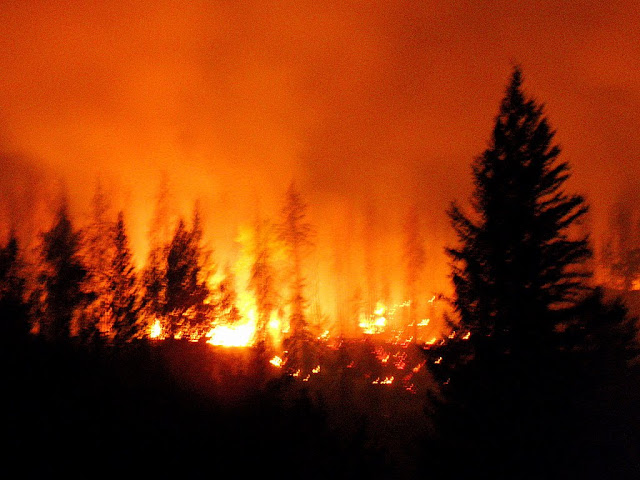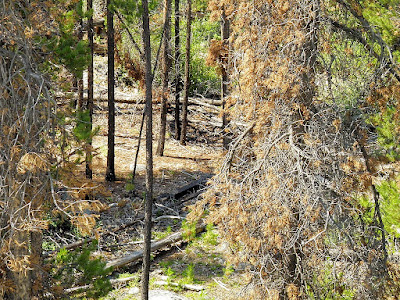Thursday evening. It's starting to rain, just a sprinkle. We sit outside under a pair of old cedars, talking about fire and smoke. The Bella Coola old-timers reminisce about previous years' rounds of fires, compare notes: fewer fires this year than last, but more area burning now; lightning strikes, burnt zones, helicopter drops; where the smoke is worst this week, where it's raining, what roads to avoid tomorrow.
Fire is an old neighbour for residents of BC's forested zones. A grumpy old neighbour, tolerated from long acquaintance, sometimes appreciated for those little acts of kindness on his good days, sometimes even relied on for jobs we can't handle on our own.
Firefighters distinguish between
"interface fire" and ordinary forest fire. The interface fire is one where the forest comes close enough to populated areas for the fire to spread from one to the other. These fires are attacked with every means available. They are the ones that generate newspaper stories and evacuations. "Pure" forest fires, on the other hand, are controlled with little fanfare, or sometimes left to burn themselves out.
One of the men under the cedars mentioned that about 400 fires are burning right now in BC. That is out of an average of around 2000 for the year, 1200 already this year, a bit more than half caused by lighting. Of these, only 3 have caused evacuations this week. Firefighting crews are working on about 100 of the fires; the others will be fine on their own.
The worst problem for most of BC, even the urban centres, is the smoke. It doesn't just hang around over the fires. It spreads everywhere. Air quality is down; people with health risks (which includes Laurie, with lung problems) are being warned to stay indoors, near their air purifying systems. Vancouver is rated "moderate" at level 5; Williams Lake, where I had planned to stay last Monday, is off the chart (1-10) at 11, or "very high". I don't think I'll stop there tomorrow, either.
I'll be driving home again, over the fire zone. The only "interface fire" I will be seeing is the Alexis Creek/Bull Canyon one. I don't think it threatens homes, but the firefighters try to keep it off the road. The other day when they called a closure, it was to allow helicopters to dump loads of fire retardant on the road itself.
Crews have been hard at work along the rest of the road, clearing dry brush and trees too close to the fences along the sides, piling it in widely-spaced mounds, making, with the road in the centre, a fire break, a boundary that fires are unlikely to jump.
Brush pile and "Chilcotin" fence
But the fire, within its limits, is a good thing.
Remember the beetles? They survive the severe Chilcotin winters, well protected under the bark of the trees they will attack in the spring. Cutting out the dead wood and hauling it away only spreads the infection.
"... in recent years, more than five times as much timber has been lost to insects and disease than has been consumed by wildfire." (Prescribed Fire)
Burning kills the beetles. It kills most of the trees, too, but there's an up side even to that.
Burned-off forest, Heckman Pass. 2009 fire.
A pine tree grows to maturity, and produces a crop of seed-bearing cones. Some hang on the trees, some the squirrels eat, some fall to the ground, with or without the tree itself.
Dry cones, dry earth, dead tree. Waiting for the fire.
"Fire is the mechanism by which the forest is continually regenerated," ... Fires consume dead, decaying vegetation accumulating on the forest floor, thereby clearing the way for new growth. Some species, such as the jack pine, even rely on fire to spread their seeds. The jack pine produces "seratonous" (resin-filled) cones that are very durable. The cones remain dormant until a fire occurs and melts the resin. Then the cones pop open and the seeds fall or blow out. (Evolving in the Presence of Fire, NASA)
That bare, blackened stand of dead trees? That was last year's fire, left to burn itself out. Next year, it will be brightened up by a thick stand of fireweed, and hummng the songs of many happy pollinating insects. Indian paint brush and dwarf lupins will line the banks of rivulets; mosses will round out the shapes of fallen trees, trap soil for the next crop of trees.
Fireweed, Coquihalla highway.
The next year, the fireweed will shelter tiny evergreen seedlings. By the time the last of the burnt wood has fallen, the fireweed will have moved on, and the new forest will be head-height. And there will be no pine beetles.


























